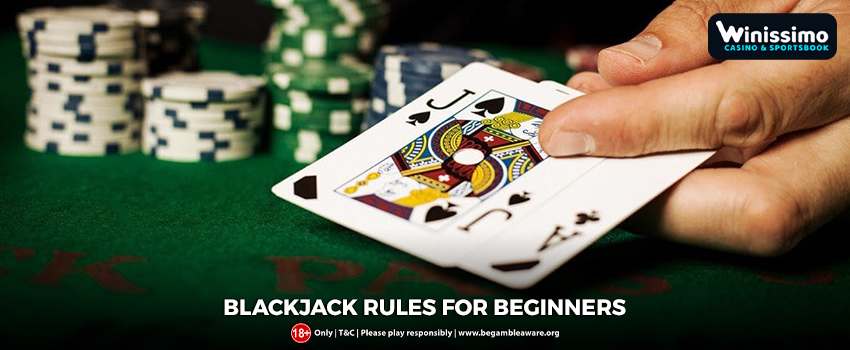
Blackjack may be frightening for those who are new to the game, or those who have never played before. No one is born prepared or knowledgeable. We all have difficulties in the beginning. The objective is to get past your fear or lack of understanding and into the game!
Winissimo is a great place to practise the tactics you are going to learn without fear of losing money or humiliating yourself in front of other players.
Blackjack is a fantastic game that should be played with no fear or apprehension on the part of the player. In spite of the fact that it may appear complicated if you are viewing it at a casino for the first time, everything is actually pretty straightforward. In order to demonstrate to you how easy this wonderful game really is, here is an account of blackjack rules. Now let’s get to the table and play!
The Setup of the Blackjack Tables
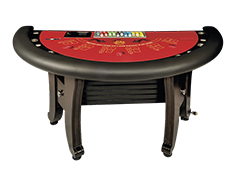
Blackjack is generally performed around a semicircular table with a number of seats that may accommodate a variety of competitors. The most frequent tables contain seven players (or “spots”), but there are tables with only five players and some with twelve! The dealer is positioned behind the table as well as the chip rack, while the players are positioned on the opposite side.
Investing in
You should sit down and await for the existing hand to be concluded before you lay your money on the blackjack table – although not into your “wagering circle or square” – and ask for a “change, please” after you have located a seat you prefer.
By doing this, you’re indicating your intent to play and requesting that the dealer turn your money into playing chips. After that, the dealer will collect your money, tally it, lay it out on the tabletop so that the Managers can see it, declare the figure, and afterwards transform the money into a corresponding number of playing chips, which may be found in different denominations.
Remember, the dealer handles everything, so you won’t have to worry about it one bit!
Values of the Cards
Number cards from 2 – 10 maintain their face value while playing blackjack, but Kings, Queens and Jacks have a value of 10, while Aces might have a valuation of 1 or 11. An Ace is usually worth 11 until it would push the hand above 21, in that case it is worth 1.
A ‘soft’ hand is one in which the Ace is worth 11 points. The rest of your hands are referred to as ‘hard’.
A natural or a blackjack is a beginning hand that consists of a ten-valued card as well as an Ace, and it defeats all other hands except another blackjack. It’s a push (tie) when both the dealer and the player get blackjack; in this case, nobody wins and the player gets their stake back.
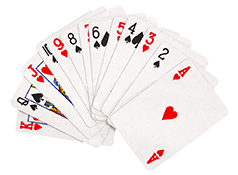
How to play blackjack
It’s game time! Let’s learn how to play blackjack. You have found a seat, exchanged your money for gaming chips, and are ready to start playing. No worries if you entered the game halfway through. Everybody will be patient until you place your first bet after exchanging your cash for gaming chips. The game may now proceed, and the dealer will start dealing.
Players who have placed a stake in the wagering area will receive cards from the dealer one. In the majority of casinos that deal from the “shoe,” the dealer will put every card in front of each player who has placed a stake, with its face-up. Active players are those who have placed a stake on the current hand.
- Following the initial pass, when each player receives their first card, the dealer will deal one card face down to himself or herself.
- If a player is handed a 2nd card, the dealer will hand himself or herself the 2nd card and afterwards turn the 1st card over face-up, slipping the 2nd card face-down under the newly exposed first. This process is repeated until all players have been dealt two cards.
- As a result, every player now gets 2 cards, one of which is face up, as is customary in shoe games. The dealer also has two cards, but only one of them is visible to the other players.
- The dealer will invite the players to make judgements regarding their hands at this stage. Each player has a turn to act as the dealer points to them one at a time, starting with the person seated in position one. This dealer action instructs each player to make a decision depending on their initial 2 cards.
These are the choices:
Stand
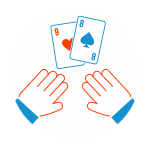
This indicates you will “stay” with the 2 cards you were dealt and will not do anything else with the present hand. In order to convey this, you just stretch your hand above the cards and softly wave it from side to side. This tells the dealer that you’re content with the cards you’ve got and don’t want to do anything extra. After that, the dealer will go to the next player in turn. Just understand that once you have made a selection, there’s no going back; the dealer will have already gone on.
Hit
When a player desires to acquire another card, they indicate this to the dealer by scraping the felt alongside their hand or indicating it. After that, a single card is dealt face up into their hand. Players who have fewer than 21 points in their hand have the option of using the Hit or Stand strategy. When the total is 21, the hand stands naturally. If the total exceeds 21, the hand is busted, the house takes the player’s stake, and the chance to act is passed to the next player.
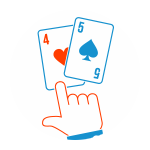
Double-Down

If you have 2 cards whose overall value may be greatly increased by only one successful hit – generally cards with an initial combined value of “10” or “11” – just tell the dealer, “Double-Down, please.” With that, the dealer will ask you to make a second wager, which is the same as the first, beside the first one. Then he or she will proceed to hand you only one card, face down, which will be placed under the second wager. Of course, you may glance at it delicately, or you can simply wait until the dealer concludes the current hand and then passes the card on to you. Some casinos, on the other hand, have the dealer deal that card face-up before moving on to the next player. Either method is very safe and will have no impact on your final result.
Split
If somehow the player’s first 2 cards have the same rank, they may opt to split the cards into 2 hands by placing an extra wager equal to their initial stake. The cards are split and an extra card is given to fill each hand when the player decides to do so. If either hand is dealt a second card of the same rank, the player may be given the opportunity to split again, however this is subject to the casino’s restrictions. In most cases, the player is limited to four hands before no more splits are permitted. Split hands are performed sequentially, from left to right of the dealer, in the sequence that they were dealt. The player has the standard options of standing, hitting, or doubling down. Certain casinos place restrictions on the card ranks that could be split, as well as the ability to double down after a pair has been split. This is a common occurrence.
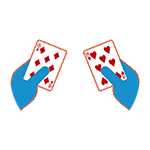
When splitting Aces, a player is generally only permitted to get one more card each hand. Players can normally divide 2 non-10-value cards, such as a Jack or a King. Certain casinos, on the other hand, limit the splitting of 10 value cards to the same ranked cards (2 Jacks for example). In any event, splitting tens is nearly always a bad move for the player. If the player splits Aces and gets a 10, or if the player splits 10s and pulls an Ace, the ensuing hand is not a blackjack, but rather a regular 21. In this instance, the player’s 2-card 21 will have a tie or push the dealer’s 21 in 3 or more cards.
Push
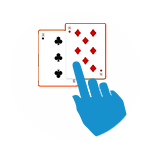
This implies that the overall value of all cards is the same for both yourself and the dealer. For instance, if your tally is 17, and the dealer’s tally is also 17, neither you nor the dealer wins or loses. It’s a “push,” a type of “stand-off” in which neither you nor the dealer loses or wins. If you “push” any hand, you have the option of continuing with the same stake for the following hand, changing the amount of that bet for the following hand, or removing all wagers and exiting the game entirely.
Bust
This indicates that after adding more cards to the hand, the overall value of your hand surpasses “21,” and you’ve lost the bet.It’s only possible if you have requested to “hit” after drawing further cards, possibly on your initial 2-card hand, or on your hand after getting the 1st card, and so forth, or on your hands following a “split.” You can never “bust” if you didn’t draw any cards.

Blackjack

Commonly known as “The Natural,” this game requires a cumulative hand value of “21,” which is made up of an Ace plus a ten-value card. As a general rule, this automatically wins and pays out at a ratio of either 3 to 2 or 6 to 5. Except if the dealer shows a 10-value card or an Ace as their up-card, this is an obvious victory. Whenever this occurs, the dealer will inquire for “Insurance,” which is a wager on whether or not the dealer also has a blackjack or natural. Simply put, do not purchase this “insurance.” It’s a terrible gamble that will make your game more difficult than it has to be. If the dealer has a blackjack as well, you “push” and risk nothing. However, in the vast majority of cases, the dealer will never have a blackjack to match yours, so relax and take pleasure in the game’s outcome and your winnings.
Surrender
Certain casinos enable players to surrender, turning up their hand in exchange for a refund of half their wager. On the hand, the player’s sole option is to surrender. The most common form, called Late Surrender, occurs after the dealer checks the hole card and determines that he or she does not hold a blackjack. The choice to surrender has become increasingly unusual in casinos.
Once all of the players have finished their activities, the dealer will play their hand as per the predetermined regulations. They’ll start by revealing their down card. Until the dealer’s hand totals 17 or more, they will continue to take cards.
Some demand the dealer to accept more cards until a total of 17 or 18+ is obtained, while others force the dealer to stand. This regulation will be prominently displayed on the table’s felt. If the dealer goes bust, all remaining player hands win.

Now there are different versions of blackjack which have a slight twist in rules here and there. Online blackjack variants are plenty and you can find many of them at Winissimo’s blackjack gallery.
The goal of Blackjack
Let’s now discuss how to play 21. Newcomers to casino Blackjack frequently believe that the goal of the game is to obtain a card-value total of “21,” or as near to it as feasible.
This is not the case.
The goal of the game is to win– and you don’t have to “get as near to 21 as possible” to do so. This is a misunderstanding. To win, you must have a higher card tally than the dealer. As well as not “busting” initially.
